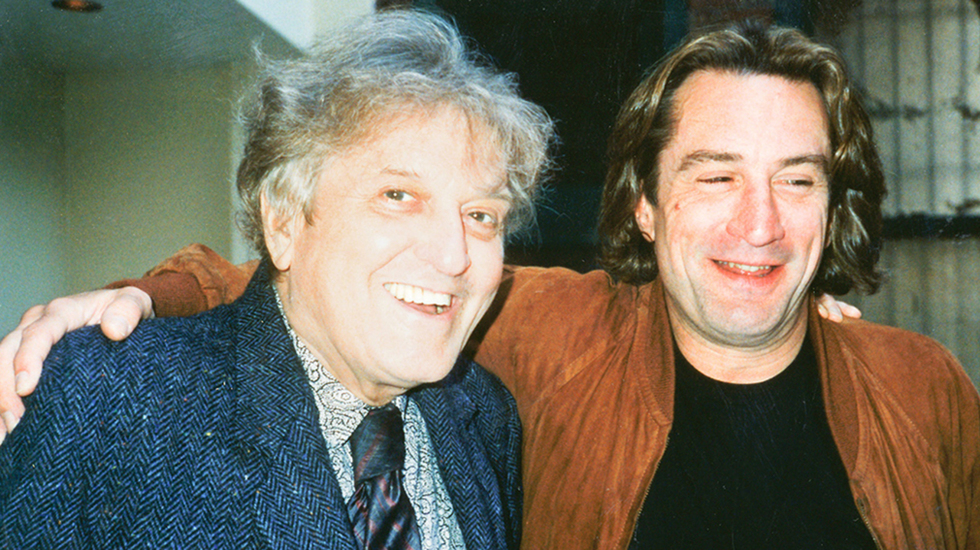
BY KAREN KEMMERLE |
‘Remembering The Artist’ Director Perri Peltz Talks Robert De Niro, Sr. And The Ever-Changing Art World
We speak to filmmaker Perri Peltz about art, the challenges of archival footage, and working with our own Robert De Niro.

Airing tonight on HBO at 9PM, Remembering The Artist: Robert De Niro, Sr. celebrates the life and works of the painter through his own words and through interviews with fellow artists and family members, including his only son, Robert De Niro. Directed by Perri Peltz and Geeta Gandbhir, this intimate tribute will help audiences “re-discover” the works of this formidable artist.
We spoke to Perri Peltz about the father/son relationship, the critical period of art history that De Niro Sr. was part of, and how exactly the documentary came to fruition.
Tribeca: Can you talk about the impetus behind Remembering The Artist: Robert De Niro, Sr.?
Perri Peltz: Bob had wanted to make a documentary about this father for some time, and Jane Rosenthal had been encouraging him to tell his father’s story for years. How I got involved was actually a stroke of good luck. I’ve done a lot of projects with Tribeca—with both Jane and Bob—over the past decade. I even had the opportunity to interview him when I was working in the news. Because of this comfort level, they approached me to do the documentary. Thankfully, the timing worked out, so here we are!
Tribeca: The film celebrated its world premiere at the 2014 Sundance Film Festival. Can you give us the basic timeline for the project?
PP: We started this project really about 2 years ago. Filming started in the summer of 2012, and we begin talking to HBO about a year later. We edited the film last summer to get it ready for Sundance. We’ve been waiting on pins and needles to show the doc on HBO—it’s been ready for a few months now.
You never know when you go into a project how something’s going to be, especially with something so intensely personal.
Tribeca: Was this doc originally intended for HBO?
PP: It was originally not intended for broadcast. The documentary started out as something Bob wanted to do for his family and children and their children. It’s almost a family archive. What I find really interesting is that over time, we all started to realize that this was a much bigger story than just Robert De Niro Sr. While the film follows what happened to him in this critical moment of American art history, his story is universal in a way. Robert De Niro Sr. was not the only figurative painter singled out— many artists in the figurative art movement shared his fate.
I think Irving Sandler said it best when describing this particular moment in American art history as “a blood bath.” Many artist got caught up in that—like Robert De Niro, Sr. He was somebody who experienced a great deal of success in his early career, but then as the art world made this shift, he became somewhat overlooked.
Tribeca: Through your use of his journals and home movies, you were able to give the audience a real sense of connection with Robert De Niro, Sr. Was it a daunting task to review these archival materials?
PP: What’s daunting is trying to make a documentary about someone who, sadly, is no longer with us. That person’s voice is gone. So the journals were enormously important to us. They were his voice throughout this film, and Bob brings them to life with his narration.
The archival material obviously took on an enormous role in documentary. I’ve never had to work in a situation in which we had to rely so heavily on that as a source of material. But ultimately, I now feel that I know Robert De Niro Sr., even though I obviously I never had the privilege of meeting him. He came alive to us in this process.

Tribeca: Your co-director, Geeta Gandbhir, also serves as the film’s editor. Can you discuss your collaborative process?
PP: Geeta and I worked together on a film that I directed called The Education of Dee Dee Ricks. We decided after that to work on another film together when we had the opportunity. We actually are in the process of editing a documentary about prison inmates training guide dogs for veterans with PTSD. During the edit, Jane and I started talking about working together on the Robert De Niro Sr. project, and it was only natural that Geeta should come onboard as well. Our collaborative process is really very natural. I did most of the interviews and focused on the editorial side of things, while Geeta with her tremendously creative mind, helped determine the look of the film and how the art was portrayed.
Tribeca: Robert De Niro Sr. was not satisfied with just making beautiful art. He longed for the recognition that peers like Jackson Pollox received. Can you discuss the burden of establishing a legacy and how that burden can impact the ways in which an artist views his or her career?
PP: That is something that was really heartbreaking in many ways. I don’t think it would happen in today’s world where there are so many outlets for different types of art. There were only a handful of galleries here in New York City back in his day, but now, there’s a countless number. The tremendous change in how people can get their art shown is largely due to the Internet.
Because we read his journals, we know that what happened in the art world during his lifetime was enormously disconcerting and confusing to him. He clearly didn’t think that pop art made sense. It wasn't something that he was going to try to do just to fit in or to be accepted. Yet, he was somebody who spoke quite openly in his journals about wanting his work to be appreciated. Plus, he was even more frustrated by the fact that his art was appreciated in the early part of his career. He was the toast of the town around New York City until the shift happened. We know that this change was a very challenging time for him emotionally. In his journals, he writes about the hope that his work will be discovered posthumously. That has been the case with many artists, so he wouldn’t be alone.
What I find really interesting is that over time, we all started to realize that this was a much bigger story than just Robert De Niro Sr.
Tribeca: There was this great deal of sadness in his life that surprised me. But I did like that you managed to include some of the moments of levity.
PP: He clearly had some issues with depression. It’s not speculation—he writes about it, and Bob talks about it. That being said, we also know that he had a great sense of humor. His friends all spoke about his humor, and you can see that at some points in his journal. So there are light spots, and I hope that the film conveys that. In addition to his profound sadness over the direction of art and his lack of recognition, he was also man who enjoyed life and loved his son. We learned through the journals and through interviews that he was enormously proud of Bob.
Tribeca: Obviously, making this film was intensely personal for Robert De Niro, and it is apparent that you had open access to him. Can you talk about working with him on this project?
PP: Working with Bob was a wonderful experience. You never know when you go into a project how something’s going to be, especially with something so intensely personal. We know that he is a very private individual for a public person. However, he was very generous with his time. I know sharing his father’s journals and letters had to be a hard thing to do. I give him tremendous credit for opening that part of his life with the public.
He did it all to be able to share his father’s art. Bob’s very clear that he’s not trying to tell people how they should feel about the art. He wants people to be able to experience it for themselves and make their own decisions. It was truly a privilege to have this opportunity to tell his father’s story.
In his journals, he writes about the hope that his work will be discovered posthumously. That has been the case with many artists, so he wouldn’t be alone.
Tribeca: How do you think having two artists as parents influenced Robert De Niro? Did he really have any other choice than to become an artist himself?
PP: That’s a funny question. I asked him myself. While he didn’t say outright that because his parents were artists, he became an artist, he does say is that he grew up accustomed to the artist’s lifestyle. He didn’t grow up envisioning the life of an insurance salesman. That kind of routine existence was far outside of his experience and that of his parent’s. At some level, I think his parent’s art did influence him, and I think he inherited his gifts from his parents—but his art is acting, not painting.
Tribeca: Did you think Robert De Niro Sr.’s legacy will be re-evaluated over the course of time? What do you hope to achieve with this documentary?
PP: When Geeta and I went into this, we knew we wanted people to walk out of the theatre cheering for him. He’s just so talented. Can a film like this turn a career around? I don’t know. Rob Storr from Yale said it best: “Robert De Niro Sr’s career is up for grabs. The last chapter has not been written.” Does this documentary change that last chapter? I don’t know, but I hope that at the very least, our calling attention to his story will give people the opportunity to look at his paintings and enjoy them. If they do that, we will be thrilled.
Remembering The Artist: Robert De Niro, Sr. airs tonight at 9PM on HBO.

